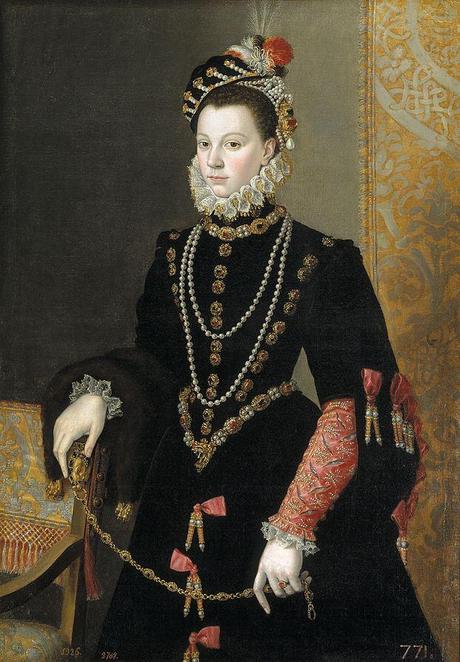
Élisabeth de Valois, de la Cruz, 1605. Photo: Prado, Madrid.
I love this portrait, it’s so stately and yet melancholy at the same time, isn’t it. Which I suppose is hardly surprising as the subject didn’t exactly have the most cheery of lives when all is said and done.
Élisabeth de Valois was born at Fontainebleau on the 2nd of April 1545, the eldest daughter and second child of Henri II (who was Dauphin at the time and remain so until he succeeded his father François I in 1547) and the formidable Catherine de’ Medici, whose marriage had been childless for over ten years before their eldest child, the future François II was born in January 1544. So desperate had the couple been to produce an heir (and it couldn’t be just any old heir either – Salic Law in France precludes women from taking the throne so they had to have a son) that poor Catherine submitted herself to all manner indignities in her efforts to conceive – such as drinking mule’s urine and applying disgusting sounding poultices made of ground stag antlers and cow dung to her private parts before having sex. In the end both she and Henri were examined by a physician Jean Fernel, who declared that they’d been doing it the wrong way all along and that they should try a different position, although unfortunately for the more prurient among you, we don’t know what that position was. Amazingly this appears to have worked and Catherine became pregnant shortly afterwards and went on to conceive nine more times over the following twelve years.
As Catherine had already produced the much longed for male heir, the birth of a daughter a year later was greeted with equanimity by the royal couple who, despite their not exactly stellar reputations were actually extremely doting parents. Catherine de’ Medici in particular was a very devoted mother who took an interest in every facet of her daughters’ upbringings and worried about their health and comfort just as much as any mother would tend to do. Certainly, the young Élisabeth gave some cause for alarm during her childhood thanks to a propensity for catching pretty much every illness doing the rounds and for being a generally sickly little girl.
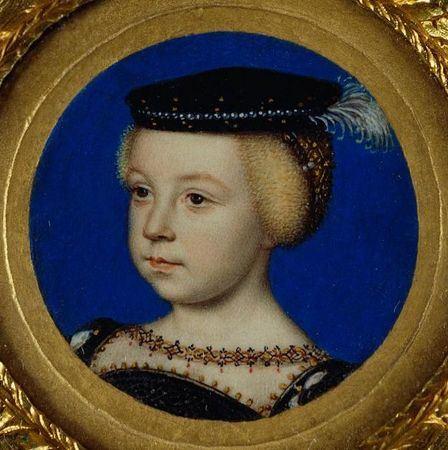
Élisabeth de Valois, Clouet, 1549.
Her childhood must have been considerably enlivened though in October 1548 when the royal children were joined in their establishment at Saint Germain en Laye by the five year old Mary Queen of Scots, who was to be raised alongside them with the view to her one day marrying the Dauphin François. Henri II ordered that Mary and Élisabeth should share a room ‘for it is the said lord’s wish that they get to know one another‘. However, in terms of courtly precedence, Élisabeth was of course expected to give way at all times to her new friend who was, after all, a crowned Queen whereas she herself was ‘merely’ a Princess of France.
However, it was always in the minds of her parents that one day Élisabeth should become a Queen herself. In 1550, it was seriously mooted that she marry the thirteen year old Edward VI of England as part of the peace terms between England and France that were signed that year. However, this scheme would come to nothing and of course Edward would die just three years later anyway.
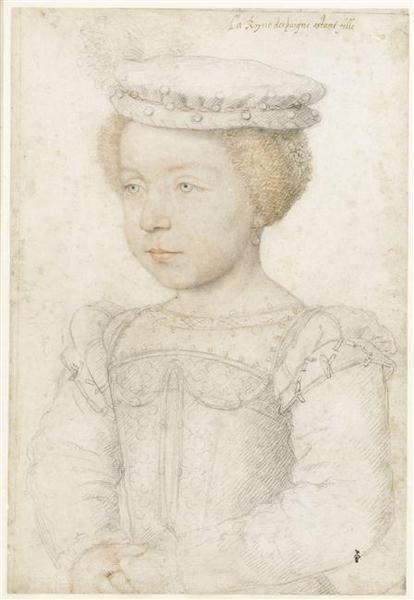
Élisabeth de Valois, Clouet, 1550. Photo: Bibliothèque national de France.
In 1558, however, an even more splendid match hove into view when it was suggested that Élisabeth be married to the thirteen year old Don Carlos of Spain, only son and heir of Philip II. However, prestigious though the Spanish crown undoubtedly was, it wasn’t exactly the most ideal of matches as there were already persistent rumours about the alleged mental instability of the young prince, probably as a result of intensive in-breeding – poor Don Carlos had only four great grandparents, whereas the rest of us plebs have a full compliment of eight.
However, fate struck a blow as it generally always does, in November 1558 when her prospective fiancé’s father Philip II suddenly became a widower after his wife, Mary I of England passed away in November 1558. Which was unfortunate for her but a stroke of good luck for young Élisabeth as it was decided that an alliance between Spain and France needed to take place sooner rather than later and so she was duly betrothed to Philip, who was no doubt also pretty keen to have some more children so that the future of his dynasty and country didn’t just lie with the unfortunate Don Carlos, instead.
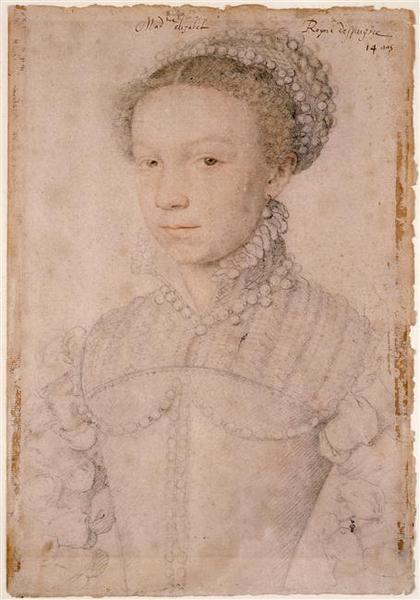
Élisabeth de Valois, Clouet, 1558. Photo: Bibliothèque national de France.
The thirteen year old Élisabeth was married by proxy to Philip II at Notre Dame in June 1559, in a splendid ceremony that underlined the extraordinary grandeur of this match between Spain and France – which was considered of such importance that the young princess was nicknamed Isabel de la Paz in tribute to the part that she played in sealing the peace. However, what should have been a happy occasion soon turned into an epic tragedy when the bride’s father, Henri II was mortally wounded during a joust that took place as part of the wedding celebrations, dying ten days later on the 10th of July 1559.
The distraught Catherine de’ Medici did everything in her power to delay parting with her eldest daughter, who was no doubt a great comfort at this time of grief, but in the end she could put it off no longer and on the 18th of November, the dowager Queen and a large retinue set off from the fabulous château at Blois to accompany Élisabeth on the first stage of her long journey to Spain. They parted company a week later, with the devastated Catherine breaking down in tears when the moment came to say goodbye to her daughter, no doubt fully aware that it was most probably the last time that she would ever set eyes upon her. She compensated for this however by starting a regular and often astonishingly candid correspondence with Élisabeth in which all the overwhelming maternal affection that she found it so difficult to display in person flowed on to the page like water, which no doubt was an immense comfort to this adolescent girl who now found herself so far away from home.
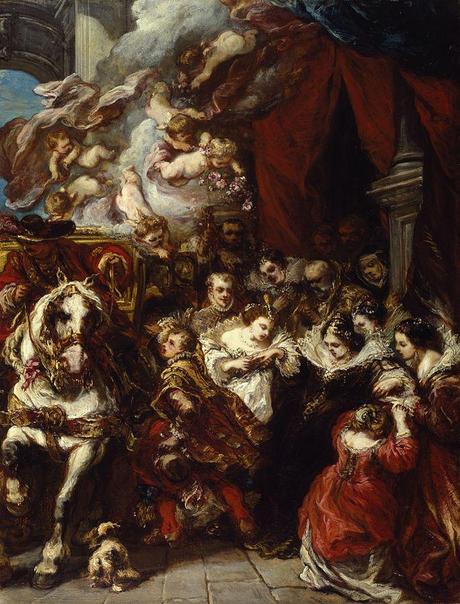
The Departure of Elisabeth of France for Spain, Isabey, 1858. Photo: Walters Art Museum. The young Élisabeth is shown half swooning in trepidation and still dressed in mourning for her father who died during the course of her wedding celebrations.
Élisabeth, who was now to be known as Isabel – the Spanish equivalent of her own name, for her part appears to have viewed her marriage in a much less emotional manner and seems to have been eager to please and also be pleased by her new husband, who was eighteen years her senior and had already buried two wives. Although historical fiction is rife with door slamming, declaiming, protesting young ladies, the simple fact of the matter is that princesses in this period were bred to be dutiful and on the whole they did as they were told when it came to marriage. In this respect, Élisabeth was not at all unusual – although her fiery and charismatic younger sister, Marguerite was a whole different kettle of fish.
Élisabeth and Philip were married as soon as she arrived in Spain on the 2nd of February 1560 and were by all accounts extremely pleased with each other, with the bride writing to tell her anxious mother that she considered herself the ‘luckiest girl in the world’ and the normally extremely reserved groom openly expressing his delight in his young bride, who was extremely pretty and blessed with elegant French courtly manners as well as a fabulous wardrobe thanks to her mother’s generosity. Certainly he treated her with marked favour and was fond of arranging fetes and entertainments that would amuse her and allowed her to make the always traditionally very stuffy atmosphere of the Spanish court much lighter and less stiffly etiquette driven. The affection between the two was definitely cemented though when Élisabeth fell ill with smallpox shortly after her arrival in Spain and Philip, despite the great personal risk to himself, remained at her side throughout her illness, which was an act of quite heroic devotion for the times.
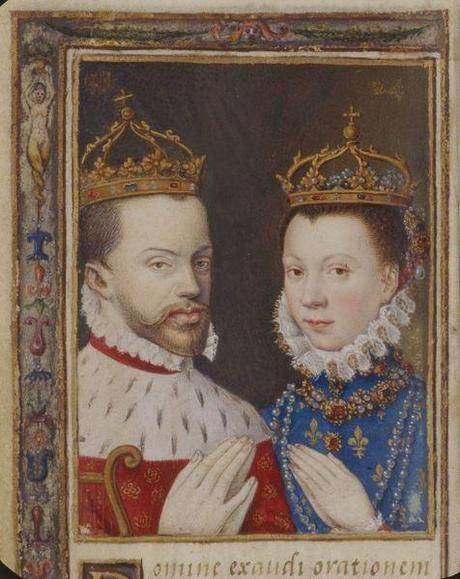
Philip II and Élisabeth de Valois in a page from Catherine de’ Medici’s Book of Hours. Photo: Bibliothèque national de France.
Relations with her young step son, who was once intended to be her husband, were more troubled, although the exact nature of what went on is still open to speculation. It seems likely however that Don Carlos had something of a crush on Élisabeth, who was, after all, close to his own age. Certainly it was noted that while he developed a tremendous loathing for his father after suffering brain damage as the result of a fall in the mid 1560s, he always treated his young step mother with a marked and contrasting tenderness. His behaviour however continued to worsen after the accident until the unfortunate Don Carlos became quite deranged and a danger to himself and others before eventually ending up incarcerated by his exasperated father and dying, probably of pneumonia, in July 1568.
Weirdly, Carlos’ instability and erratic and often sadistic behaviour did very little to diminish his marital prospects though, with even Élisabeth’s former playmate and sister in law, Mary Queen of Scots considering him as a husband after the untimely death of François in 1560. Perhaps predictably, Catherine de’ Medici was incensed by this plan when it became known to her and sent her daughter coded letters urging her to put a stop to Mary’s scheme as she could forsee Élisabeth’s own position in Spain being completely undermined should, God forbid, Philip die and Carlos and Mary ascend to the throne in her place. She’d also totally had enough of Mary’s ambitious and vainglorious Guise relatives and was keen to squash any pretensions to further influence that they might have. Instead, she suggested that Don Carlos marry her youngest daughter Marguerite to further cement the precious Spanish/French alliance but Philip wasn’t keen to proceed.

Élisabeth de Valois, Anguissola, c1559. Photo: Kunsthistorisches Museum, Vienna.
Both Catherine and Élisabeth were overjoyed when in 1565 Philip agreed that mother and daughter could enjoy a brief reunion, although he himself would not be present. By this time, Élisabeth was twenty years old and had been away from France for six years so we can imagine how she felt to be reunited with her younger brother Charles IX on a floating barge in the Bidassoa river before being escorted with great pomp (and as stipulated by her husband no Huguenots in the vicinity) to nearby Saint Jean de Luz where her impatient mother was waiting for her along with her younger siblings. The royal ladies were deeply moved to be back in each other’s company again although Catherine was less than pleased by the loyalty that her daughter, who now seemed in many ways more Spanish than French, now clearly felt for her husband and adopted country, which was at that point somewhat at odds with Catherine’s own policies.
The fact that Élisabeth had yet to have a living child (she gave birth to a stillborn son in late 1560 followed by miscarried twin girls in 1564, which almost killed her) must also have been of some concern for while her marriage remained childless it meant that the now entirely unstable Don Carlos was still in the running to succeed to the throne after his father. Happily though, she finally gave birth to a daughter, Isabella Clara Eugenia on the 12th of August 1566, followed by another girl, Catherine Michelle on the 10th of October (my birthday too, fact fans!) 1567. Although Philip no doubt hoped for sons from his much loved wife, he was besotted with his two girls and proved to be a doting father despite being, much like his dread mother-in-law Catherine de’ Medici, somewhat less than demonstrative in nature.
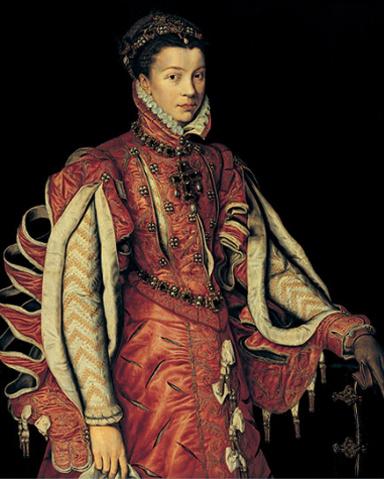
Élisabeth de Valois, Coello, c1560. Photo: Várez Fisa Collection, Madrid.
However, poor Élisabeth did not live to enjoy her family for very long. She became pregnant again in the spring of 1568 but it all ended in tragedy when the young Queen of Spain, who was just twenty three years old, gave birth to a stillborn daughter then died herself on the 3rd of October, much mourned by her adoring husband and mother, whose last letter to Spain, full of advice and chivying the no doubt long suffering Philip to make sure that her daughter ate better had been sent on the 18th of October by which time, of course, Élisabeth was already dead.
Catherine was devastated by her daughter’s death, the news of which was broken to her by her son, Charles IX himself who was worried that she might collapse from sorrow as she had been so fond of Élisabeth. In this he was correct, but Catherine nonetheless made an appearance at a council meeting that same day where she announced her intention that the newly widowed Philip should now marry her younger daughter Marguerite in order to keep the alliance between the two countries going strong. Philip, however, was having none of this and brusquely made it quite clear to his overbearing former mother-in-law that no such match would ever take place, not just because it was totally against his own personal beliefs (Philip clearly being a Leviticus man through and through unlike Certain Other Monarchs That I Could Mention) but because he completely disapproved of Catherine’s at the time moderate religious policies. I’m sure he felt utterly vindicated in his stance when Catherine and Charles IX then went on to marry Marguerite to the Protestant Henry of Navarre instead, which of course caused no end of trouble but that’s a story for another day…
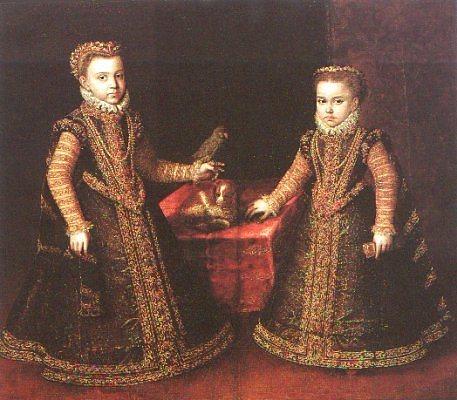
The Infantas Isabella and Catherine of Spain, Anguissola, 1570. The young daughters of Philip II and Élisabeth de Valois look very solemn here, poor little things.
******
Set against the infamous Jack the Ripper murders of autumn 1888 and based on the author’s own family history, From Whitechapel is a dark and sumptuous tale of bittersweet love, friendship, loss and redemption and is available NOW from Amazon UK and Amazon US.
‘Frothy, light hearted, gorgeous. The perfect summer read.’ Minette, my young adult novel of 17th century posh doom and intrigue is now 99p from Amazon UK and 99c from Amazon US. CHEAP AS CHIPS as we like to say in dear old Blighty.
Blood Sisters, my novel of posh doom and iniquity during the French Revolution is just a fiver (offer is UK only sorry!) right now! Just use the clicky box on my blog sidebar to order your copy!
Follow me on Instagram.
